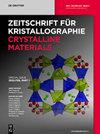利用脱湿模型而不是成核模型:当前界面和纳米材料研究中的晶体学挑战
IF 2.7
4区 材料科学
Q3 CRYSTALLOGRAPHY
Zeitschrift Fur Kristallographie-Crystalline Materials
Pub Date : 2022-03-07
DOI:10.1515/zkri-2021-2078
引用次数: 0
摘要
摘要没有哪个科学模型能像经典的成核理论(CNT)那样塑造晶体学。所有生长过程和颗粒形成过程的大部分都归因于CNT。然而,存在可能更适合解释某些条件下材料形成的替代描述。其中一个替代方案是去湿理论(DWT)。为了更详细地描述DWT的可能性,我们为当前的三个应用领域选择了三种材料系统:硅上的金颗粒作为纳米线生长的催化剂,钼上的铟颗粒作为新型太阳能电池概念中的前体材料,硅锗上的硅层作为半导体量子计算机中的势阱。这些材料体系中的每一种都显示出DWT相对于CNT的特殊优势。例如,使用DWT可以更真实地描述具有高原子迁移率的表面粒子的性质。然而,有明确的迹象表明,DWT尚未完成,需要进一步的研究来完成它。特别是,现代晶体学的挑战可以达到这一目的,例如半导体量子计算机的开发,以便重新评估CNT和DWT等已知模型,并使其适应最新的科学技术状态。就目前而言,本文将对DWT的优势及其在晶体学研究中的潜力进行展望。本文章由计算机程序翻译,如有差异,请以英文原文为准。
Leveraging dewetting models rather than nucleation models: current crystallographic challenges in interfacial and nanomaterials research
Abstract No scientific model has shaped crystallography as much as the classical nucleation theory (CNT). The majority of all growth processes and particle formation processes are attributed to the CNT. However, alternative descriptions exist that may be better suited to explain material formation under certain conditions. One of these alternatives is the dewetting theory (DWT). To describe the possibilities of DWT in more detail, we selected three material systems for three current application areas: Gold particles on silicon as catalysts for nanowire growth, indium particles on molybdenum as precursor material in novel solar cell concepts, and silicon layers on silicon germanium as potential wells in semiconductor quantum computers. Each of these material systems showed particular advantages of DWT over CNT. For example, the properties of surface particles with high atomic mobility could be described more realistically using DWT. Yet, there were clear indications that the DWT is not yet complete and that further research is needed to complete it. In particular, modern crystallographic challenges could serve this purpose, for example the development of semiconductor quantum computers, in order to re-evaluate known models such as the CNT and DWT and adapt them to the latest state of science and technology. For the time being, this article will give an outlook on the advantages of the DWT today and its potential for future research in crystallography.
求助全文
通过发布文献求助,成功后即可免费获取论文全文。
去求助
来源期刊

Zeitschrift Fur Kristallographie-Crystalline Materials
CRYSTALLOGRAPHY-
CiteScore
2.00
自引率
16.70%
发文量
55
期刊介绍:
Zeitschrift für Kristallographie – Crystalline Materials was founded in 1877 by Paul von Groth and is today one of the world’s oldest scientific journals. It offers a place for researchers to present results of their theoretical experimental crystallographic studies. The journal presents significant results on structures and on properties of organic/inorganic substances with crystalline character, periodically ordered, modulated or quasicrystalline on static and dynamic phenomena applying the various methods of diffraction, spectroscopy and microscopy.
 求助内容:
求助内容: 应助结果提醒方式:
应助结果提醒方式:


